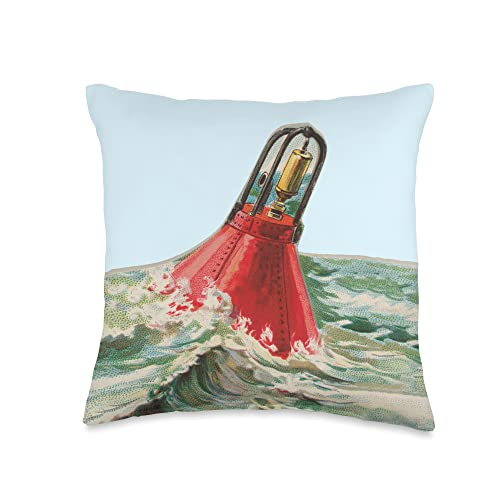Whether cruising along the coast or transiting crowded harbors, prudent mariners constantly reference the marks and meanings of the buoys around them. Among the most vital of these navigational aids are can buoys – the red and green markers that denote port and starboard sides in channel approaches using the lateral system of buoyage.
Can buoys provide indispensable reference points that guide vessels safely into ports and along confined waterways. By understanding the distinguishing shape, color, number and light characteristics, captains can quickly identify can buoys and determine their significance. Read on for an in-depth look at the key role these ubiquitous aids play in coastal navigation and how to safely transit areas marked by can buoys.
What is a Can Buoy?
A can buoy refers to a cylindrical navigational buoy typically used to mark channels along coasts and connect navigable rivers to the open ocean. Can buoys attach to anchor lines and float upright in the water column. They earned the “can” moniker from their hollow cylindrical shape.
The lateral system of buoyage uses red and green can buoys to indicate port and starboard sides along waterways. The meanings conveyed by can buoys’ color, numbering and markings are universally recognized by mariners across the world. Reference to these buoys allows safely navigating constricted passages into harbors, across bars, and on approach to piers or shoreside facilities.
How are Can Buoys Marked?
The distinguishing shape, color, markings and light patterns exhibited on can buoys carry significant meaning. Here are the key ways can markers are identified:
Shape
Can buoys feature a straight-sided cylindrical float section wider at the base that houses ballast to remain upright. The cylindrical shape contrasts conical buoys used for cardinal markings.
Color
Solid green denotes starboard side buoys, while solid red indicates port side. Buoys are painted vivid red and green for clear visibility.
Numbering
Odd numbers designate starboard buoys while even numbers mark port side buoys when proceeding from open water into port. Numbers increase sequentially.
Daymark
Painted bands encircling the buoy also indicate direction relative to the channel centerline and hazards.
Topmark
If used, a shape mounted atop the buoy also clarifies direction – a cone or cylinder for starboard, and sphere for port side.
Light Characteristic
Many feature a navigational light with a distinct intermittent flash pattern like Fl G 4s on starboard or Fl R 4s on port side.
These distinguishing can buoy characteristics allow mariners to readily identify the markers and interpret their significance.
What Do the Different Can Buoy Markings Mean?
Beyond indicating direction, can buoy markings also relay what lies in given directions. Here are the meanings:
Port Side Can Buoys
Marked red with even numbers. Indicate safest water is to the buoy’s port side with channel center or hazards to starboard. Display spherical topmark if used.
Starboard Side Can Buoys
Marked green with odd numbers. Safest water and channel are toward the buoy’s starboard side with shoals or hazards to port. May have conical or cylindrical topmark.
Mid-Channel Buoys
Painted with red and green bands to mark middle of safe passage. Pass close to either side.
Special Purpose Buoys
May have yellow geometric shapes like diamonds to indicate quarantine zones, swimming areas or other regulated regions.
So in summary, red and green can buoys simply direct: “Pass me close aboard, and you’ll stay safe!” This meaning transcends language barriers, aiding navigation worldwide.
How to Use Can Buoys to Navigate Safely
By properly reading and following can buoy markers, mariners can safely transit even unfamiliar harbors and approaches:
Follow the Lateral Buoyage System
Keep green can buoys to starboard and reds to port when moving from open waters into port. This keeps boat in safe channel area.
Read All Markings
Note numbering, daymark bands and any topmarks to confirm you are correctly interpreting the buoy’s significance and not off-course.
Avoid Obstructions
Give wide berth to any hazard warnings from yellow caution buoys attached to red/green cans to avoid dangers.
Reference Charts
Confirm buoy locations and numbers match those charted to validate understanding.
Set Bearings Between Buoys
Line up fixed ranges and aim chord lines from one buoy to the next to stay mid-channel.
Consider Tidal Current
Factor in tidal set and drift which may alter buoy positions slightly from charted locations.
With practice, the red and green can buoys become trusted gatekeepers ushering mariners into port. But never lose focus on carefully identifying and interpreting their significance!
Examples of Can Buoys in Context
To reinforce proper understanding of these ubiquitous markers, here are real world examples:
- A solid green can buoy marked with the number “1” lies off a river mouth’s northern jetty. This indicates stay north of the buoy when entering from sea.
- A red cylindrical can buoy displaying Fl R 4s marks the hazard to its north – a charted shoal area. Pass south of the buoy.
- A set of mid-channel buoys runs down the center of an inlet painted with red and green bands. Navigate between them.
- A red can buoy sits just outside the harbor breakwall, advising avoid the rocks to its north when approaching the gap.
These scenarios reflect how prudent mariners apply can buoyage markings to safely navigate real areas. Consistently heeding the advice of these markers makes transiting harbor entrances more secure even when short on local knowledge.
Conclusion
Can buoys and their system of lateral markings provide indispensable navigational references for mariners worldwide. Red and green cans of contrasting numbers, patterns and topmarks convey unambiguous directional and hazard information to guide vessels safely to port. By properly identifying, understanding and respecting can buoys, captains can confidently navigate channels from open water regardless of familiarity. So keep a sharp eye out for these steadfast sentinels! The ubiquitous can buoys will stand ready 24/7 to escort you in.











